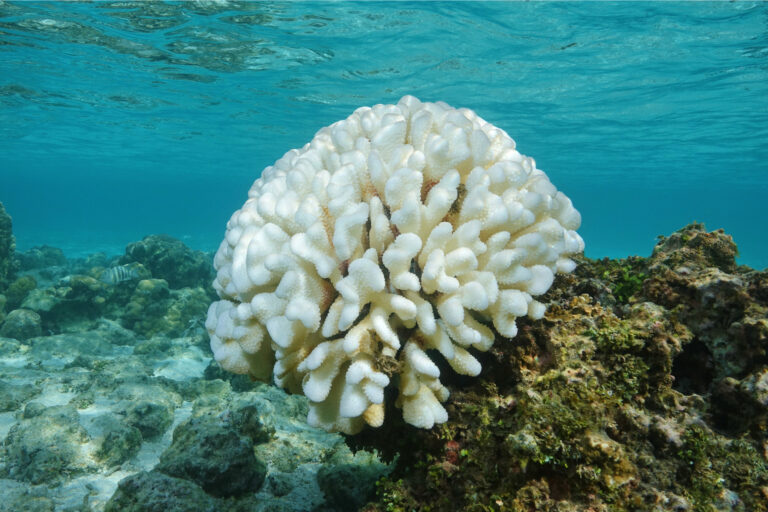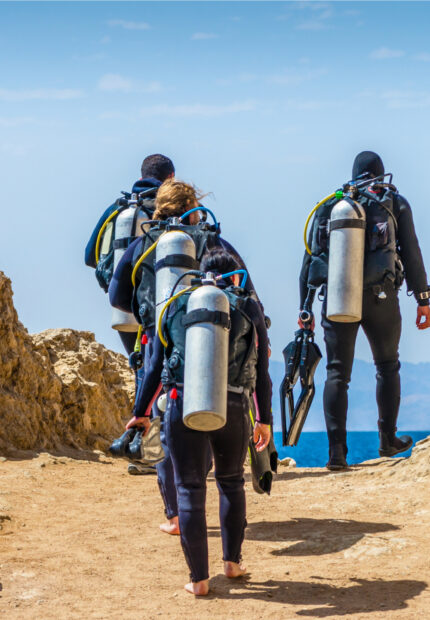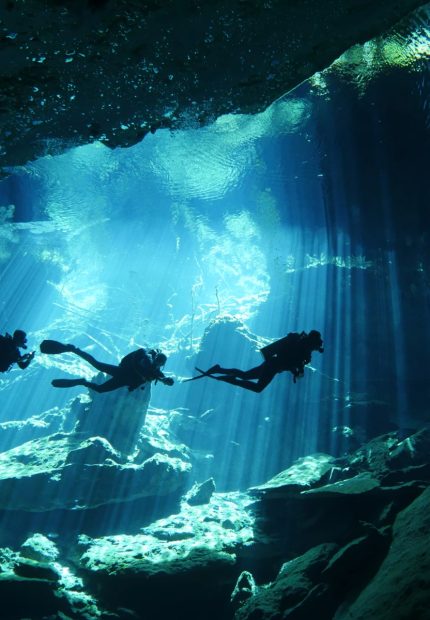
What is Reef Bleaching and What Can We Do About It?
As travellers, we witness some pretty incredible things. If you dive, snorkel, or just enjoy spending time near the ocean, you’ll probably have seen how stunning coral reefs can be.
Coral reefs cover less than 0.1% of the ocean’s surface area. Yet, they are among the most diverse ecosystems, hosting thousands of species of organisms. Reefs are critical to the health of our oceans. However, they are increasingly under threat from a phenomenon known as reef bleaching.
Here, we’ll go through what reef bleaching is, why it matters, and how we can minimise our impact to make sure coral reefs survive for generations to come!
Ready? Let’s dive in!
WHAT IS REEF BLEACHING?
Let’s flash back to high school biology for a second. Corals form symbiotic relationships with an algae called zooxanthellae. The coral provides a protected and safe ‘home’ for the algae. And, the algae, like all plants, can photosynthesise and create the sugars and oxygen that the corals need to thrive.
But what does this have to do with reef bleaching? Well, reef bleaching occurs when corals get stressed by changes in their environment. This makes them get rid of these symbiotic algae.
And this is a problem. These algae are crucial for coral health. Coral need the sugars and oxygen from the algae that are harder to get elsewhere. Algae are also the reason that corals are so colourful. When expelled, the coral turns white (or bleaches) and becomes more susceptible to disease and death.

Bleached corals are unhealthy corals!
WHAT CAUSES REEF BLEACHING?
So, what causes reef bleaching? Here are the main things that can stress coral reefs:
- Rising Sea Temperatures: We all know that climate change is causing the seas to warm up. Even a slight increase in water temperature can stress corals, and long-term temperatures 1-2°C above the norm can trigger bleaching. This is already happening around the world.
- Ocean Acidification: Increased levels of carbon dioxide make the ocean more acidic. This stops corals from growing and thriving and can cause bleaching if levels get too high.
- Pollution: Chemicals, oil, and sewage that get into the ocean can poison coral reefs. This can be industry-caused, such as this large oil spill in Mauritius, or improper waste disposal from cruise ships. Or, it can be caused by individuals, such as those who use sunscreen and lotions that aren’t reef-safe.
- Overexposure to Sunlight: Where we tan, corals bleach! Too much UV radiation is dangerous for both corals and humans. The only difference is, we can cover up or use sunscreen. Corals can’t.
- Low Tides: Extreme low tides can expose corals to the air, which can cause them to dry out and bleach.
WHY SHOULD WE CARE ABOUT REEF BLEACHING?
Coral reefs are more than just beautiful features to enjoy during your holiday swimming, diving and snorkelling. They are habitats for so many ocean species. Coral reefs provide homes for small fish, which keep the larger animals, such as dolphins, sharks, whales, and turtles well-fed. Reefs are also important for communities, who rely on sustainable fishing for food and income.
Here’s why we should care about coral bleaching:
1.
Biodiversity: Coral reefs are home to about 25% of all ocean species. They provide homes for fish, food for turtles, and places for octopus to hide and sleep away the day. Without reefs, we’ll start to see a lot of marine species decline, from small fish, to huge whales.
2.
Coastal Protection: Ever sat on an island with a calm turquoise ocean, watching the waves break miles away? Well, they’re breaking on the reef! Reefs act as natural barriers, protecting coastlines from erosion, storms, and even tsunamis. This makes them super important for the safety and security of island communities too.
3.
Economic Value: Healthy reefs support local economies! According to some estimates, coral reefs contribute billions of dollars each year to the global economy – particularly through sustainable fishing. Reefs also keep the ocean surface calm, making it perfect for swimming and relaxing. Tourists come to dive, snorkel, and swim, providing tourism income for communities round the globe.
4.
Medical Research: It might not be the first thing that springs to mind, but the chemicals found in reefs are being studied for their potential in treating diseases such as cancer, arthritis, and bacterial infections. So far, it’s been positive!
5.
Climate Regulation: Corals are able to capture carbon and use it to grow. This means that they can take carbon dioxide, and lock it away permanently, which is super important considering that CO2 is one of the main gases contributing to global warming. This means that reefs play an important role in global climate regulation!
Losing coral reefs would not only mean the loss of good diving, but also the collapse of the ecosystems and economies the reefs support.

There should be more colour on the reef than just the fish
SO, WHAT CAN WE DO TO MINIMISE OUR IMPACT?
Whether we travel, dive, snorkel, or swim, we have a responsibility to minimise our impact on the planet, and this includes coral reefs! Here’s what we can do to limit our negative contributions to coral bleaching
#1 CHOOSE SUSTAINABLE OPERATORS
If you’re planning to go diving or snorkelling, look for operators committed to sustainable practices. Some dive companies state their policies towards sustainable and eco-friendly diving on their websites. Organisations such as Green Fins or the Reef-World Foundation can also certify dive shops. But eco-friendly and sustainable diving could also look like:
- Dive centres that brief divers on eco-friendly and responsible diving alongside the generic pre-dive brief
- A dive instructor or divemaster who looks out for, and corrects divers who are not practicing good buoyancy
- Smaller dive groups, which are easier to monitor
- Dive centres that have environmental practices, such as using reusables instead of single-use plastic between dives and minimising water and electricity consumption
- Enforcing the use of reef-safe sunscreen or providing full-length wetsuits or rash guards as alternative sun protection.
- A company that supports marine conservation and scientific research projects
- The boats you dive from use mooring buoys instead of anchoring on the seabed.
- Employing local people and not relying on international dive instructors
#2 PRACTICE RESPONSIBLE DIVING AND SNORKELLING
Don’t ever forget the basics from your Open Water course. Check your buoyancy before you descend and practice good buoyancy control throughout your dive. This will prevent you from damaging coral reefs and stirring up sediment, which can impact wildlife.
Mind Your Fins. Whether you are diving or snorkelling, be aware of where your fins are to avoid kicking corals (or your friends, a fin to the face is no fun), and stirring up sediment.
And don’t touch the corals! I know they’re pretty, but avoid touching, standing on, or collecting corals. Corals have delicate structures and can easily break or crumble when touched. Corals also have a protective coating, and the oils and bacteria in your skin can remove this which makes them more vulnerable. Once a coral is damaged, it can take a while to grow back. So best not to touch them at all. And definitely don’t collect them. Marine life should never be a souvenir.
#3 USE REEF-SAFE SUNSCREEN
Or avoid wearing sunscreen entirely! Caring for your skin is important. But if you’re going to swim anywhere near coral reefs, you need to stay clear of the sunscreen or make sure you choose reef safe sunscreen that’s 100% biodegradable!
Many sunscreens contain chemicals harmful to corals and other ocean wildlife. Opt for mineral-based sunscreens containing zinc oxide or titanium dioxide and apply them well before entering the water. Or better yet, avoid sunscreen, and cover up with a t-shirt instead!
You shouldn’t use any other oils or lotions either. Scientists say that environmental contaminants in your favourite skincare products can be just as damaging!
#4 SUPPORT CONSERVATION EFFORTS
Want to dive for free? Some dive shops organise weekly cleanup dives to remove debris and litter from the ocean. By joining these, the cost of your dive will be reduced, it may even be free, and you’ll be helping to remove trash from the ocean. Talk about a win-win scenario!
You can also look into volunteering with organisations working to protect coral reefs. Check out sites like Workaway, and have a look at our guide to sustainable volunteering abroad (make sure you avoid the negative ‘voluntourism’)
The fun doesn’t have to stop once you get home either. You can donate to or volunteer with local conservation projects such as beach, lake, or river clean-ups and coral or seagrass restoration programs if this is applicable in your area.
#5 REDUCE YOUR PERSONAL FOOTPRINT
Ok, I know that the idea of a ‘carbon footprint’ was invented by Big Oil to push the blame onto us, the consumer, and detract from their negative impacts. And I know that 100 companies are responsible for 71% of global emissions. But if we can all do our bit to reduce our personal emissions, it’ll still have an impact.
Here are our top tips and sustainable guides to help you reduce your impact:
- What is sustainable travel? (+ 23 tips to travel more sustainably!)
- Overtourism: what’s the solution?
- The Beginners’ guide to offsetting your carbon emissions and 5 things they don’t tell you about carbon offsetting…
- 10 sustainable swaps to pack for your next trip
- 7 tips to be eco-conscious in the outdoors

A healthier reef
THE BIGGER PICTURE: GLOBAL ACTIONS FOR REEF CONSERVATION
Your actions are important, but at the end of the day, you’re just one person. That isn’t meant to dissuade you – if every individual made a positive change we’d be in a much better place! But, collective efforts at local, national, and global levels are essential to limit reef bleaching.
Here are a few things we’ve seen on our adventures to spread a little hope at the end of this somewhat heavier-than-normal blog post.
- Mexico’s sunscreen ban: Not only are the oils in sunscreen damaging to marine life (including corals), but they also can leave oily residues in the water. Mexico, particularly around the popular tourist area of the Riviera Maya, is limiting or outright banning the use of sunscreen in and around beaches, lakes, and cenotes. Travellers are asked to use biodegradable sunscreen only, cover up in the water to avoid sunburn, and only use sunscreen after they are out of the ocean.
- Costa Rica’s community engagement: There were so many opportunities to work with local communities in Costa Rica – especially those that depend on reefs for their livelihoods. Costa Rica had so many opportunities to volunteer to develop sustainable practices and protect oceans, beaches, and marine life.
- Egypt and Belize’s Marine Protected Areas. You might never have heard of a Marine National Park, but you can find these across the world. One example is the Ras Mohammed National Park in Egpyt, a protected area where coral reef restoration is taking place and the wildlife are thriving! The diving here is excellent, but rules are strictly enforced. Belize also has a large marine protected area. Here you can swim with manatees and dive with sharks in a more sustainable and wildlife-friendly way!
Reef bleaching is a sad reminder of just how fragile the ecosystems on our planet are. As travellers, we are in a unique position to witness both the beauty and the vulnerability of coral reefs.
By taking steps to minimise our impact, supporting conservation efforts, and advocating for broader environmental protections, we can help ensure that these underwater treasures continue to thrive.
Let’s dive responsibly and travel sustainably, not just for the sake of the reefs, but for the countless species and communities that depend on them. Our actions today will determine the health and vibrancy of coral reefs for generations to come.
Follow our daily adventures on Facebook and Instagram
Disclaimer: The information and advice provided in this blog are the author’s opinions and based on their personal experiences. All information was accurate at the time of writing. However, things can change quickly, so always double-check current conditions and guidelines before setting out. Remember, your travels and safety are your own responsibility, and this blog can not be held responsible for anything that might happen on your adventures! Always exercise caution and good judgment. Oh, and don’t forget to get travel insurance! Happy travels!
This post may contain affiliate links (yay for transparency!) This means that I will earn a small commission, at no additional cost to you, if you click the link and choose to buy the product. I only link to stuff I have personally bought and found useful and never endorse crap. Your support helps keep the site going, thank you!
Alice
Alice is a UK travel blogger who advocates sustainable travel and being more eco-conscious on a budget. She loves coffee, her houseplants and summiting mountains.
You May Also Like

Sharm el Sheikh VS Dahab: Where’s best in Egypt for your Red Sea diving?
June 22, 2024
From Mexico to Panama: the ultimate guide to diving in Central America
September 7, 2024